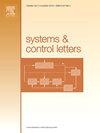L∞/L2 Hankel norm analysis of linear periodically time-varying systems and detection of critical instants
IF 2.5
3区 计算机科学
Q3 AUTOMATION & CONTROL SYSTEMS
引用次数: 0
Abstract
This paper deals with the Hankel norm analysis of linear periodically time-varying (LPTV) systems, where is taken as the (past) input space and the (future) output is regarded as an element in . This norm is known to be important because of its coincidence with the well-known norm for the special case of single-output linear time-invariant systems. For the period of LPTV systems, an arbitrary instant is first taken to separate past and future, and then the quasi Hankel norm at is defined. A computation method for the quasi Hankel norm for each is further derived, and for the Hankel norm defined as the supremum of the quasi Hankel norms over , its alternative and direct computation method is also provided, which is actually completely free from dealing with any quasi Hankel norms. A relevant question of whether the supremum is attained as the maximum is also studied, in which case each maximum-attaining is called a critical instant. In particular, it is discussed when and how the existence/absence of a critical instant can be determined and some or all critical instants can be detected without directly computing all (or any of) the quasi Hankel norms over . Finally, numerical examples are provided to illustrate the arguments of this paper.
线性周期时变系统的L∞/L2汉克尔范数分析及临界时刻检测
本文研究线性周期时变(LPTV)系统的Hankel范数分析,其中L2作为(过去)输入空间,(未来)输出作为L∞上的一个元素。这个范数是非常重要的,因为对于单输出线性定常系统的特殊情况,它与H2范数是一致的。对于LPTV系统的周期h,首先取任意时刻Θ∈[0,h]来区分过去和未来,然后定义Θ处的拟L∞/L2 Hankel范数。进一步推导了每个Θ的拟L∞/L2 Hankel范数的计算方法,对于定义为Θ∈[0,h]上的拟L∞/L2 Hankel范数的上零点的L∞/L2 Hankel范数,也提供了其替代的直接计算方法,实际上完全不需要处理任何拟L∞/L2 Hankel范数。还研究了是否达到最高作为最大值的相关问题,在这种情况下,每个达到最大值Θ称为临界时刻。特别地,讨论了在不直接计算Θ∈[0,h]上的所有(或任何)拟L∞/L2 Hankel范数的情况下,何时及如何确定临界瞬间的存在/不存在,以及如何检测部分或全部临界瞬间。最后,给出了数值算例来说明本文的论点。
本文章由计算机程序翻译,如有差异,请以英文原文为准。
求助全文
约1分钟内获得全文
求助全文
来源期刊

Systems & Control Letters
工程技术-运筹学与管理科学
CiteScore
4.60
自引率
3.80%
发文量
144
审稿时长
6 months
期刊介绍:
Founded in 1981 by two of the pre-eminent control theorists, Roger Brockett and Jan Willems, Systems & Control Letters is one of the leading journals in the field of control theory. The aim of the journal is to allow dissemination of relatively concise but highly original contributions whose high initial quality enables a relatively rapid review process. All aspects of the fields of systems and control are covered, especially mathematically-oriented and theoretical papers that have a clear relevance to engineering, physical and biological sciences, and even economics. Application-oriented papers with sophisticated and rigorous mathematical elements are also welcome.
 求助内容:
求助内容: 应助结果提醒方式:
应助结果提醒方式:


